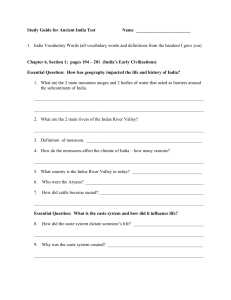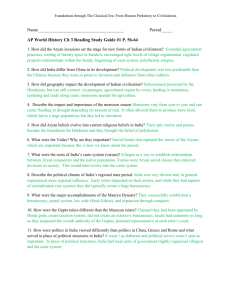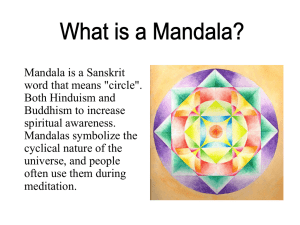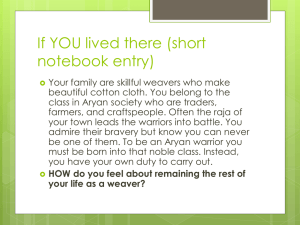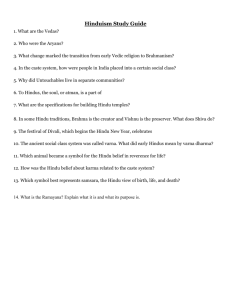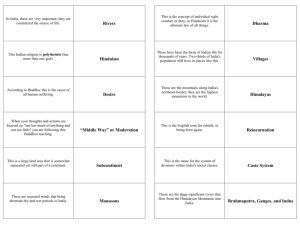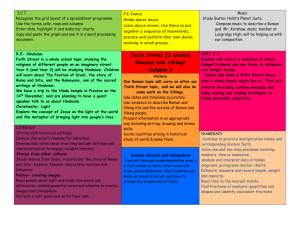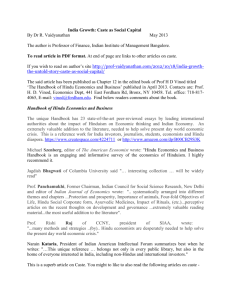Big Era XXXX - School of Humanities
advertisement
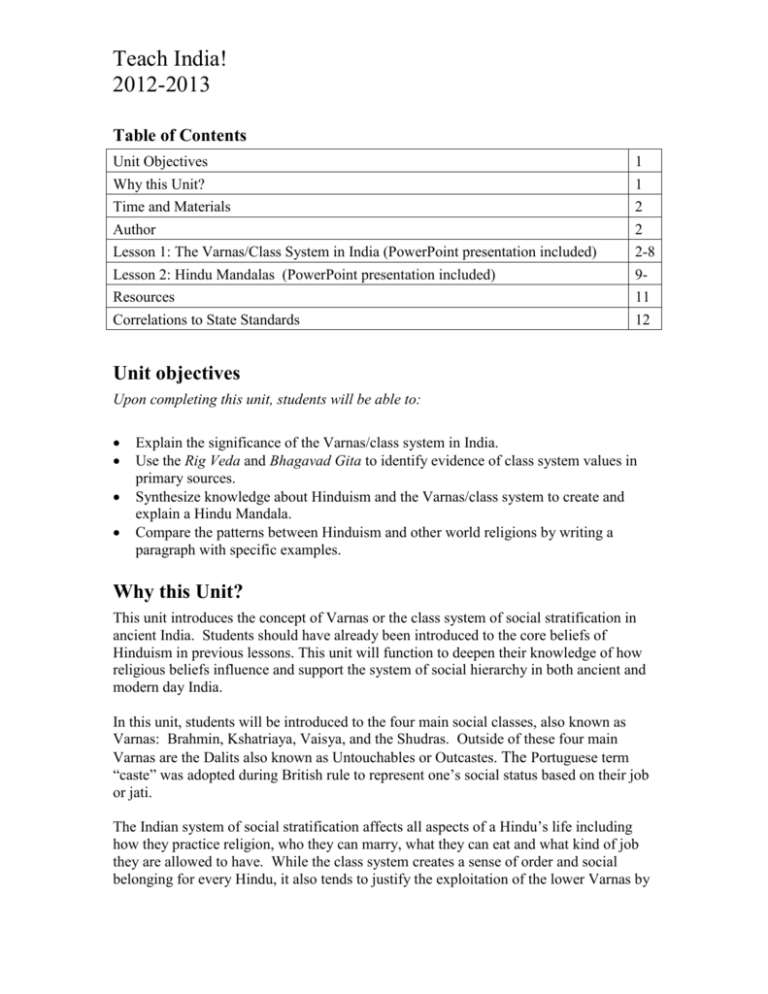
Teach India! 2012-2013 Table of Contents Unit Objectives Why this Unit? Time and Materials Author Lesson 1: The Varnas/Class System in India (PowerPoint presentation included) tT Lesson 2: Hindu Mandalas (PowerPoint presentation included) Resources 1 1 2 2 2-8 910 11 Correlations to State Standards 12 Unit objectives Upon completing this unit, students will be able to: Explain the significance of the Varnas/class system in India. Use the Rig Veda and Bhagavad Gita to identify evidence of class system values in primary sources. Synthesize knowledge about Hinduism and the Varnas/class system to create and explain a Hindu Mandala. Compare the patterns between Hinduism and other world religions by writing a paragraph with specific examples. Why this Unit? This unit introduces the concept of Varnas or the class system of social stratification in ancient India. Students should have already been introduced to the core beliefs of Hinduism in previous lessons. This unit will function to deepen their knowledge of how religious beliefs influence and support the system of social hierarchy in both ancient and modern day India. In this unit, students will be introduced to the four main social classes, also known as Varnas: Brahmin, Kshatriaya, Vaisya, and the Shudras. Outside of these four main Varnas are the Dalits also known as Untouchables or Outcastes. The Portuguese term “caste” was adopted during British rule to represent one’s social status based on their job or jati. The Indian system of social stratification affects all aspects of a Hindu’s life including how they practice religion, who they can marry, what they can eat and what kind of job they are allowed to have. While the class system creates a sense of order and social belonging for every Hindu, it also tends to justify the exploitation of the lower Varnas by the higher Varnas. Article 15 of the Indian Constitution explicitly prohibits discrimination based on castes, but much discrimination against the Dalit population still exists today. Time and materials This unit should take about a week to a week and a half of class time to complete. Teachers need a computer and LCD project to show the PowerPoint presentations created for this unit. Teachers will also need colored pencils for students to complete the Hindu Mandala activity at the end of the unit. Author Linda Cargile has been a world history teacher at Bancroft Middle School in Long Beach Unified School District for over 13 years. Linda is her school’s GATE coordinator and has given many professional presentations on strategies teachers can use to differentiate their lessons for advanced learners. Over the years, Linda has served as a collaborating master teacher mentoring many student teachers enrolled in the credentialing program at California State University, Long Beach. She is member of the World History for Us All team, a web based curriculum which presents the human past as a single story rather than unconnected stories of many civilizations. Linda is a curriculum writer and gives presentations at history conferences on how teachers can incorporate strategies and unit plans from World History for Us All in their classrooms. Lesson 1 The Varnas/Class System in India Preparation Students should have a general understanding of Hinduism and its core beliefs prior to their study of the Varnas/class system. Introduction In this lesson, students will learn about the Varnas/class system in India through listening and taking notes on a mini lecture and class discussions and by reading excepts from the Rig Veda and Bhagavad Gita and answering questions. Activities This lesson includes a PowerPoint on the Caste System in India for the teacher to use as a class lecture. It is accompanied by a handout for students to take notes during lecture using the cloze method (fill in the blank). After giving students background information on the Varnas/class system, the class will read and answer questions from two primary source readings to deepen their understanding of the topic. 2 Page 3 Page Lesson 1 Student Handout 1.1: The Varnas/Class System in India Origins of the Varnas Varnas/Class System in India was/is a system of social _________________that determines social _____________. All people in India are born into one of the four major Varnas known as ____________. According to Hindu belief, the four Varnas were formed from the body of the god ______________. Varnas/Class Part of Purusha Jatis/Castes Brahmin head Priests, teachers Kshatriaya shoulders Warriors, rulers Vaisya thighs Commoners, Farmers. Merchants, artisans Shudra feet servants Outcastes- the Untouchables Dalit none- considered outside the caste system Did the work that was the most unclean, “polluted labor” Duties Big Ideas • The idea of different classes of people is supported by Hindu ideas of ___________, dharma, and _________________. Being born into a particular caste was thought of as reflecting good or bad deeds of the previous life. • The class system allows people to find a unique _________________in Indian society. But it also facilitated _____________________ of the poor by the wealthy and powerful. 4 Page Changes Over Time: The Class System Today Article 15 of Indian ________________, passed in 1950, prohibits any discrimination based on caste. The government has set up the “________________” system (positive discrimination) which sets up quotas for certain jobs. However this has led to protests as people complain of reverse _________________. The Untouchable/Dalit population is about __________of the total population of India, around 165 million. There is still much discrimination and ______________committed against them. Questions for Discussion 1. What are the patterns between the class system in India and other systems of social hierarchy? 2. How does the class system contribute to order in Indian society? 3. What are the major ethical issues of dividing people in classes? 4. Do you think that Hindus would have the same perspective of the “fairness” of the class system as Americans today would? Explain. 5 Page Teacher’s Key to Student Handout 1.1: The Varnas/Class System in India Origins of the Varnas • Varnas/Class System in India was/is a system of social hierarchy that determines social status. • All people in India are born and ranked into one of the four major Varnas. Each Varna contains a variety of jati (castes) that are associated with occupation and fluctuate with changing economic and social conditions • According to Hindu belief, the four Varnas were formed from the body of the god Purusha. Varnas/Class Brahmin Part of Purusha head Jatis/Castes Priests, teachers Duties Teach people about Hinduism Kshatriaya shoulders Warriors, rulers Protect society Vaisya thighs Commoners, Farmers. Merchants, artisans Work the land Shudra feet servants Serve classes higher than them Not allowed to hear, repeat the Vedas Outcastes- the Untouchables Dalit None- considered outside the caste system Did the work that was the most unclean, “polluted labor” Cremating corpses, handling the skins of dead animals, sweeping, cleaning latrines (toilets) Big Ideas • The idea of different classes of people is supported by Hindu ideas of karma, dharma, and reincarnation. Being born into a particular caste was thought of as reflecting good or bad deeds of the previous life. • The class system allows people to find a unique identity in Indian society. But it also facilitated exploitation of the poor by the wealthy and powerful. 6 Page Changes Over Time: The Caste System Today • Article 15 of Indian Constitution, passed in 1950, prohibits any discrimination based on class. • The government has set up the “reservation” system (positive discrimination) which sets up quotas for certain jobs. However this has led to protests as people complain of reverse discrimination. • The Untouchable/Dalit population is about 16% of the total population of India, around 165 million. There is still much discrimination and crimes committed against them. Questions for Discussion 1. What are the patterns between the class system in India and other systems of social hierarchy? 2. How does the class system contribute to order in Indian society? 3. What are the major ethical issues of dividing people in classes? 4. Do you think that Hindus would have the same perspective of the “fairness” of the class system as Americans today would? Explain. 7 Page Lesson 1 Student Handout 1.2: The Rig Veda on the Origin of the Varnas A thousand heads hath Purusha, a thousand eyes, a thousand feet. He covered earth on every side and spread ten fingers’ breadth beyond. All creatures are one-fourth of him… He formed the creatures of the air, and animals both wild and tame. When they divided Purusha, how many parts did they make? What do they call his mouth, his arms? What do they call his thighs and feet? The Brahmin was his mouth, of both his arms was the kshatriya made. His thighs became the vaishya, from his feet the shudra was produced. The moon was born from his mind, and from his eye the sun had birth; Indra and Agni [the god of fire] from his mouth were born, and Vayu [the wind] from his breath. Forth from his navel came mid-air; the sky was fashioned from his head; Earth from his feet, and from his ear the regions. Thus they formed the worlds. SOURCE: Ralph T. Griffth, trans. The Hymns of the Rigveda, 4 vols., 2nd ed. Benares: E.J. Lazarus, 1889-92, 4:289-93. Questions for Discussion 1. What does this story explain to Hindus? 2. What is the symbolism of assigning different Varnas to different parts of the body? 3. How is the Hindu origin story similar to others you know about? 8 Page Lesson 1 Student Handout 1.3: Caste Duties According to the Bhagavad Gita As a man, casting off old clothes, puts on others and new ones, casting off old bodies, goes to others and new ones. Weapons do not divide the self into pieces; fire does not burn it; waters do not moisten it; the wind does not dry it up. … Even if you think that the self is constantly born and constantly dies, still, O you of mighty arms, you ought not to grieve thus. For to one that is born, death is certain; and to one that dies, birth is certain. Therefore about this unavoidable thing, you ought not to grieve… Having regard to your own duty, you ought not to falter, for there is nothing better for a kshatriya than a righteous battle. Happy those kshatriyas who can find such a battle—an open door to heaven! But if you will not find this righteous battle, then you will have abandoned your own duty and your fame, and you will incur sin. All beings, too, will tell of your everlasting infamy; and to one who has been honored infamy is a greater evil than death. Warriors who are masters of great chariots will think that you have withdrawn from the battle through fear, and having been highly thought of by them, you will fall down to littleness. Your enemies, too, will speak much about you that should not be spoken. And what, indeed, could be worse than that? Killed, you will go to heaven; victorious, you will enjoy the earth. Therefore arise, to engage in battle. Looking on pleasure and pain, on gain and loss, on victory and defeat as the same, prepare for battle, and thus you will not incur sin. SOURCE: the Bhagavad Gita. Trans. By Kashinath Trimbak Telang in F. Max Muller, ed. The Sacred Books of the East, col. 8. Oxford: Clarendon Press, 1908, pp. 45-48. Fill in the box below using evidence from the text above. Hindu Belief Evidence from the text Karma Dharma Reincarnation 9 Page Lesson 2 Hindu Mandalas Preparation Students should have a general understanding of the core beliefs of the Varnas/Class System and Hinduism in order to create pictures and symbols for their mandala. Introduction In this lesson, students will use what they have learned about Hinduism from previous lessons and the Varnas/Class System to illustrate and explain an original Hindu Mandala. Activities This lesson includes a PowerPoint on Mandalas to be shown to students. After looking at actual mandalas and example work from other students, your students should be able to create their own mandala. By showing the slides of the PowerPoint, the class will learn the definition of a mandala and different examples of what they look like. This project may be worked on as an independent project or in pairs. Depending on how you implement the project, students may need several class periods to plan, design and then explain the significance of their mandalas. This activity may be used as an assessment for what they learned about Hinduism and the Caste System. Materials Students will need an outline of a mandala or they may need a compass to create their own. Students should have colored pencils for coloring. 10 Page Student Handout 2.1 Project: Hindu Mandalas Objective: You will you use details you have learned about Hinduism and Varnas/Class System to create and explain a mandala. What is a Mandala? The word "mandala" is from the ancient Indian language of Sanskrit. Loosely translated to mean "circle," a mandala is far more than a simple shape. It represents wholeness, and can be seen as a model for the organizational structure of life itself--a cosmic diagram that reminds us of our relation to the infinite, the world that extends both beyond and within our bodies and minds. Mandala Requirements You must have 5 different pictures to symbolize 5 different Hindu beliefs we have learned about in class. Each belief must be labeled. Your mandala must be neatly colored and cut out (if using the outline given in class). You should use colored pencil to color your mandala; no markers or highlighters please. Paragraph Requirements Language of the Discipline: You need at least one paragraph which explains each of the 5 Hindu beliefs you made pictures for on your mandala (minimum 5 sentences). Patterns: You need a paragraph which compares at least 3 patterns between Hinduism and any other world religion we have studied this year. (minimum 5 sentences). Both paragraphs need to be either typed or neatly written in blue or black ink. Name(s)/period/appear on the upper right hand corner of your paragraphs. 11 Page Resources Resources for teachers Mines, Diane. Caste in India: Key Issues in Asian Studies. Association for Asian Studies: Ann Arbor, 2009. An short concise guide to the history of the caste system in India which includes information on how caste functions in contemporary India. Trautmann, Thomas. India: Brief History of a Civilization. New York: Oxford University Press, 2011. Resources for students Chatterjee, Manini. India (Eyewitness Books). Dorling Kindersley: London, 2002. This is a wonderful series that explains key topics about India in two pages each through pictures and short concise paragraphs. Genera, Anita. What Do We Know About Hinduism? Hotter Wayland Children’s, 1999. Each chapter begins with a different question about one of the key concepts or beliefs in Hinduism and answers questions with student friendly explanations. Patel, Sanjay. A Little Book of Hindu Deities. Penguin Books Ltd.: London, 2006. A beautifully illustrated book. Each has a page summary on each of the major gods and goddesses with an illustration. Patel, Sanjay. Ramayana: Divine Loophole. Chronical Books: San Francisco, 2010. A visual feast! A beautifully illustrated abridged version of the Ramayana that both children and adults will enjoy. Penney, Sue. World Beliefs and Cultures: Hinduism. Heinemann Library: Chicago, 2001. A kid friendly overview of all the major aspects of the Hindu religion including core beliefs, celebrations and family occasions. 12 Page Correlations to State Standards California: History-Social Science Content Standard Standards for Grade Six 6.5 Students analyze the geographic, political, economic, religious, and social structures of the early civilizations of India. 2. Discuss the significance of the Aryan invasions. 3. Explain the major beliefs and practices of Brahmanism in India and how they evolved into early Hinduism. 4. Outline the social structure of the caste system. 13 Page
